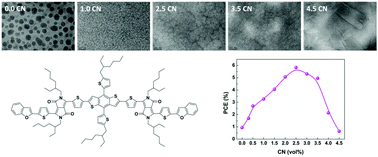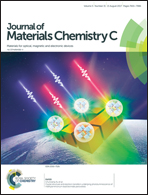Effects of morphology evolution on solution-processed small molecule photovoltaics via a solvent additive†
Abstract
A newly synthesized small molecule donor, BDTT-2DPPBFu, is designed for incorporation into the photo-active layer in solution-processed small molecule organic photovoltaics (SM-OPVs). The effects of a solvent additive (1-chloronaphthalene, CN) on the bulk heterojunction morphology of a BDTT-2DPPBFu donor:fullerene derivative acceptor (PC71BM) are investigated and correlated with the device performance. A TEM analysis revealed that the nanomorphology of the SM-OPVs evolved dramatically with increasing solvent additive volume. With an optimum concentration of 2.5 vol% CN, a nanomorphology with a fibrillar and interpenetrating network on the order of exciton diffusion length (∼10–15 nm) is formed, resulting in improvement of the short-circuit current density, fill factor, and power conversion efficiency. Further GIWAXS studies have shown that the π–π stacking distance of BDTT-2DPPBFu small molecules is reduced and the inter-mixing of PC71BM within the BDTT-2DPPBFu-rich phase in the photo-active layer processed from 2.5 vol% CN is increased, leading to enhanced charge transport and reduced charge recombination and transfer resistance. The present work provides important progress in the nanomorphology of the photo-active layer, which can be effectively tuned via the use of a solvent additive in SM-OPVs.



 Please wait while we load your content...
Please wait while we load your content...